

СДЕЛАЙТЕ СВОИ УРОКИ ЕЩЁ ЭФФЕКТИВНЕЕ, А ЖИЗНЬ СВОБОДНЕЕ
Благодаря готовым учебным материалам для работы в классе и дистанционно
Скидки до 50 % на комплекты
только до
Готовые ключевые этапы урока всегда будут у вас под рукой
Организационный момент
Проверка знаний
Объяснение материала
Закрепление изученного
Итоги урока

Сборник текстов по английскому языку для специальности "Техническая эксплуатация"
Данное учебное пособие предназначено для студентов специальности «Техническая эксплуатация подъёмно-транспортных, дорожных, строительных машин и оборудования (по отраслям)» по дисциплине «Английский язык». В пособие включены технические тексты и тексты для дополнительного чтения. Материал представлен для изучения и закрепления специальной лексики будущих специалистов.
Просмотр содержимого документа
«Сборник текстов по английскому языку для специальности "Техническая эксплуатация"»
Государственное бюджетное профессиональное образовательное учреждение
Нижегородской области
Краснобаковский лесной колледж
Сборник текстов
по английскому языку
для специальности «Техническая эксплуатация подъёмно-транспортных, дорожных, строительных машин
и оборудования (по отраслям)»
Составила: преподаватель
английского языка
высшей категории
Воронина М.В.
Красные Баки
2016
| РАССМОТРЕНО
на заседании ПЦК «Общеобразовательных, социально-экономических, гуманитарных и естественно-научных дисциплин»
Председатель _______________ | ОДОБРЕНО методическим советом ГБПОУ НО «КБЛК» Протокол №__________ от___________________ Председатель _____________________ |
Данное учебное пособие предназначено для студентов специальности «Техническая эксплуатация подъёмно-транспортных, дорожных, строительных машин и оборудования (по отраслям)» по дисциплине «Английский язык». В пособие включены технические тексты и тексты для дополнительного чтения. Материал представлен для изучения и закрепления специальной лексики будущих специалистов.
Содержание
| I. Materials and their properties | 4 |
| 1.1 Metals | 4 |
| 1.2. Steel | 5 |
| 1.3. Plastics | 6 |
| 1.4. Types of plastics | 7 |
| 1.5. Mechanical properties of materials (part 1) | 9 |
| 1.6. Mechanical properties of materials (part 2) | 10 |
| 1.7. Composite materials | 12 |
| II. Metalwork and joinery | 13 |
| 2.1. Machine tools | 13 |
| 2.2. Lathe | 13 |
| 2.3. Milling machine | 14 |
| 2.4. Dies | 16 |
| 2.5. Welding | 17 |
| 2.6. Other types of welding | 19 |
| III. Mechanisms and parts of machines | 21 |
| 3.1. Parts of a car | 21 |
| 3.2. How cars work | 22 |
| 3.3. Separating the main parts | 23 |
| 3.4. Classification of engines | 24 |
| IV. Forest machines | 27 |
| 4.1. Harvester (forestry) | 27 |
| 4.2. Felling head | 27 |
| 4.3. Forwader | 28 |
| 4.4. Skidder | 28 |
| 4.5. Chipper | 31 |
| 4.6. Feller buncher | 31 |
| V. Traffic, rules and laws | 33 |
| 5.1. Traffic | 33 |
| 5.2. Traffic code | 33 |
| 5.3. Driving laws | 34 |
| 5.4. Rules of the road | 35 |
| 5.5. Traffic signs | 35 |
| Список использованной литературы и интерне-источников | 38 |
Vocabulary:
property — свойство
metallurgy — металлургия
dense — плотный
arrangement — расположение
to slide — скользить
malleable — ковкий, податливый, способный деформироваться
bent (от bend) — гнуть
to fracture — ломать
ductile — эластичный, ковкий
to draw — волочить, тянуть
wire — проволока
lead — свинец
iron — железо, чугун
grain — зерно
composition — состав
coarse — грубый, крупный
treatment — обработка
quenching — закалка
tempering — отпуск после закалки, нормализация
annealing — отжиг, отпуск
rolling — прокатка
to hammer — ковать (напр. молотом)
extrusion — экструзия
metal fatigue — усталость металла
creep — ползучесть
stress — давление,
failure — повреждение, разрушение
vessel — сосуд, котел, судно
lathe — токарный станок
milling machine — фрезерный станок
shaper — строгальный станок
grinder — шлифовальный станок
to cast — отливать, отлить
mould — форма (для отливки)
Metals are materials most widely used in industry because of their properties. The study of the production and properties of metals is known as metallurgy.
The separation between the atoms in metals is small, so most metals are dense. The atoms are arranged regularly and can slide over each other. That is why metals are malleable (can be deformed and bent without fracture) and ductile (can be drawn into wire). Metals vary greatly in their properties. For example, lead is soft and can be bent by hand, while iron can only be worked by hammering at red heat.
The regular arrangement of atoms in metals gives them a crystalline structure. Irregular crystals are called grains. The properties of the metals depend on the size, shape, orientation, and composition of these grains. In general, a metal with small grains will be harder and stronger than one with coarse grains.
Heat treatment such as quenching, tempering, or annealing controls the nature of the grains and their size in the metal. Small amounts of other metals (less than 1 per cent) are often added to a pure metal. This is called alloying (легирование) and it changes the grain structure and properties of metals.
All metals can be formed by drawing, rolling, hammering and extrusion, but some require hot-working. Metals are subject to metal fatigue and to creep (the slow increase in length under stress) causing deformation and failure. Both effects are taken into account by engineers when designing, for example, airplanes, gas-turbines, and pressure vessels for high-temperature chemical processes. Metals can be worked using machine-tools such as lathe, milling machine, shaper and grinder.
The ways of working a metal depend on its properties. Many metals can be melted and cast in moulds, but special conditions are required for metals that react with air.
Steel
Vocabulary:
alloy — сплав
carbon— углерод
stiff — жесткий
to corrode — разъедать, ржаветь
rusty — ржавый
stainless — нержавеющий
to resist — сопротивляться
considerably — значительно, гораздо
tough — крепкий, жесткий, прочный, выносливый
forging — ковка
welding — сварка
brittle — хрупкий, ломкий
cutting tools — режущие инструменты
surgical instruments — хирургические инструменты
blade — лезвие
spring — пружина
inclusion — включение
to affect — влиять
manganese — марганец
silicon — кремний
rust-proof — нержавеющий
nitrogen — азот
tungsten — вольфрам
The most important metal in industry is iron and its alloy — steel. Steel is an alloy of iron and carbon. It is strong and stiff, but corrodes easily through rusting, although stainless and other special steels resist corrosion. The amount of carbon in a steel influences its properties considerably. Steels of low carbon content (mild steels) are quite ductile and are used in the manufacture of sheet iron, wire, and pipes. Medium-carbon steels containing from 0.2 to 0.4 per cent carbon are tougher and stronger and are used as structural steels. Both mild and medium-carbon steels are suitable for forging and welding. High-carbon steels contain from 0.4 to 1.5 per cent carbon, are hard and brittle and are used in cutting tools, surgical instruments, razor blades and springs. Tool steel, also called silver steel, contains about 1 per cent carbon and is strengthened and toughened by quenching and tempering.
The inclusion of other elements affects the properties of the steel. Manganese gives extra strength and toughness. Steel containing 4 per cent silicon is used for transformer cores or electromagnets because it has large grains acting like small magnets. The addition of chromium gives extra strength and corrosion resistance, so we can get rust-proof steels. Heating in the presence of carbon or nitrogen-rich materials is used to form a hard surface on steel (case-hardening). High-speed steels, which are extremely important in machine-tools, contain chromium and tungsten plus smaller amounts of vanadium, molybdenum and other metals.
Vocabulary:
carbon — углерод
flexible — гибкий
fibre — волокно, нить
chain — цепь
identical — одинаковый, идентичный
molecule — молекула
branch — разветвленный
to synthesize — синтезировать
chemicals — химические вещества
to soften — смягчать
cellulose — клетчатка, целлюлоза
wax — воск
thermosetting plastics — термореактивные пластмассы
to harden — делать твердым
coil — спираль
stretched — растянутый
transparent — прозрачный
rubber — резина, каучук
to decompose — разлагаться
soft-drink — безалкогольный напиток
to subject — подвергать
polyurethane — полиуретан
resin — смола
similar — сходный, подобный
sufficient — достаточный
to prevent — предотвращать
Plastics are non-metallic, synthetic, carbon-based materials. They can be moulded, shaped, or extruded into flexible sheets, films, or fibres. Plastics are synthetic polymers. Polymers consist of long-chain molecules made of large numbers of identical small molecules (monomers). The chemical nature of a plastic is defined by the monomer (repeating unit) that makes up the chain of the polymer. Polyethene is a polyolefin; its monomer unit is ethene (formerly called ethylene). Other categories are acrylics (such as polymethylmethacrylate), styrenes (such as polystyrene), vinys (such as polyvinyl chloride (PVC)), polyesters, polyurethanes, polyamides (such as nylons), polyethers, acetals, phenolics, cellulosics, and amino resins. The molecules can be either natural — like cellulose, wax, and natural rubber — or synthetic — in polyethene and nylon. In co-polymers, more than one monomer is used.
The giant molecules of which polymers consist may be linear, branched, or cross-linked, depending on the plastic. Linear and branched molecules are thermoplastic (soften when heated), whereas cross-linked molecules are thermosetting (harden when heated).
Most plastics are synthesized from organic chemicals or from natural gas or coal. Plastics are light-weight compared to metals and are good electrical insulators. The best insulators now are epoxy resins and teflon. Teflon or polytetrafluoroethene (PTFE) was first made in 1938 and was produced commercially in 1950.
Plastics can be classified into several broad types.
1. Thermoplastics soften on heating, then harden again when cooled. Thermoplastic molecules are also coiled and because of this they are flexible and easily stretched.
Typical example of thermoplastics is polystyrene. Polystyrene resins are characterized by high resistance to chemical and mechanical stresses at low temperatures and by very low absorption of water. These properties make the polystyrenes especially suitable for radio-frequency insulation and for parts used at low temperatures in refrigerators and in airplanes. PET (polyethene terephthalate) is a transparent thermoplastic used for soft-drinks bottles. Thermoplastics are also viscoelastic, that is, they flow (creep) under stress. Examples are polythene, polystyrene and PVC.
2. Thermosetting plastics (thermosets) do not soften when heated, and with strong heating they decompose. In most thermosets final cross-linking, which fixes the molecules, takes place after the plastic has already been formed.
Thermosetting plastics have a higher density than thermoplastics. They are less flexible, more difficult to stretch, and are less subjected to creep. Examples of thermosetting plastics include urea-formaldehyde or polyurethane and epoxy resins, most polyesters, and phenolic polymers such as phenol-formaldehyde resin.
3. Elastomers are similar to thermoplastics but have sufficient cross-linking between molecules to prevent stretching and creep.
adhesion — прилипание
adhesive — клей
bond — связи, узы
insulation — изоляция
casting — литье
void — пустота
solid — твердое тело, твердый
acid — кислота
alkali — щелочь
to obtain — доставать, получать
granule — гранула
solution — раствор
lattices — латексы
paste — паста
yield — выход
durable — прочный
rubber — резина, каучук
garment — предметы одежды
lens —линза
capacitor — эл. конденсатор
syringe — шприц
light-duty — неответственный
envelope — зд. обрамление
impact — удар
improved — улучшенный
modifiers — модификаторы
addition — добавление
readily — легко, с готовностью
foam — пена
catalyst — катализатор
wax — воск
reasonable — приемлемый, неплохой
coating — слой, покрытие
1. Epoxy resin.
Epoxy resin is a thermoset plastic containing epoxy groups. Epoxy resin hardens when it is mixed with solidifier and plasticizer. Plasticizers make a polymer more flexible.
Epoxy resins have outstanding adhesion, toughness, and resistance to attack from chemicals. They form strong bonds and have excellent electrical insulation properties. Large, complex, void-free castings can be made from them. They are also used as adhesives, and in composites for boat building and sports equipment.
2. PVC (polyvinyl chloride)
PVC (polyvinyl chloride) is a thermoplastic polymer made from vinyl chloride is a colourless solid with outstanding resistance to water, alcohols, and concentrated acids and alkalis. It is obtainable as granules, solutions, lattices, and pastes. When compounded with plasticizers, it yields a flexible material more durable than rubber. It is widely used for cable and wire insulation, in chemical plants, and in the manufacture of protective garments. Blow moulding of unplasticized PVC produces clear, tough bottles which do not affect the flavour of their contents. PVC is also used for production of tubes or pipes.
3. Polystyrene.
Polystyrene is a thermoplastic produced by the polymerization of styrene. The electrical insulating properties of polystyrene are outstandingly good and it is relatively unaffected by water. Typical applications include light fixtures, toys, bottles, lenses, capacitor dielectrics, medical syringes, and light-duty industrial components. Extruded sheets of polystyrene are widely used for packaging, envelope windows, and photographic film. Its resistance to impact can be improved by the addition of rubber modifiers. Polystyrene can be readily foamed; the resulting foamed polystyrene is used extensively for packaging.
4. Polythene (polyethene, polyethylene)
Polythene (polyethene, polyethylene) is a plastic made from ethane. It is one of the most widely used important thermoplastic polymers. It was first developed by the polymerization of ethane at a pressure of 2,000 bar at 200°C. This produced low-density polythene (LDPE). A relatively high-density form (HDPE) was synthesized in the 1950s using a complex catalyst. Polythene is a white waxy solid with very low density, reasonable strength and toughness, but low stiffness. It is easily moulded and has a wide range of uses in containers, packaging, pipes, coatings, and insulation.
Mechanical properties of materials (part 1)
Vocabulary
bar— брусок, прут
compression — сжатие
creep — ползучесть
cross-sectional area — площадь поперечного сечения
cyclic stress — циклическое напряжение
decrease — уменьшение
elastic deformation — упругая деформация
elastic limit — предел упругости
exceed — превышать
external forces — внешние силы
fracture — перелом, излом
loosen — ослаблять, расшатывать
permanent deformation — постоянная деформация
remaining — оставшийся
shear — срез
simultaneously — одновременно
technique — методы
tension — напряженность
to propagate — распространяться
to meet the needs — отвечать требованиям
to occur — происходить
to respond — отвечать реагировать
torsion — кручение
twisting — закручивание, изгиб
volume — объем, количество
rupture — разрыв
Materials Science and Technology is the study of materials and how they can be fabricated to meet the needs of modern technology. Using the laboratory techniques and knowledge of physics, chemistry, and metallurgy, scientists are finding new ways of using metals, plastics and other materials.
Engineers must know how materials respond to external forces, such as tension, compression, torsion, bending, and shear. All materials respond to these forces by elastic deformation. That is, the materials return their original size and form when the external force disappears. The materials may also have permanent deformation or they may fracture. The results of external forces are creep and fatigue.
Compression is a pressure causing a decrease in volume. When a material is subjected to a bending, shearing, or torsion (twisting) force, both tensile and compressive forces are simultaneously at work. When a metal bar is bent, one side of it is stretched and subjected to a tensional force, and the other side is compressed.
Tension is a pulling force; for example, the force in a cable holding a weight. Under tension, a material usually stretches, returning to its original length if the force does not exceed the material's elastic limit. Under larger tensions, the material does not return completely to its original condition, and under greater forces the material ruptures.
Fatigue is the growth of cracks under stress. It occurs when a mechanical part is subjected to a repeated or cyclic stress, such as vibration. Even when the maximum stress never exceeds the elastic limit, failure of the material can occur even after a short time. No deformation is seen during fatigue, but small localized cracks develop and propagate through the material until the remaining cross-sectional area cannot support the maximum stress of the cyclic force. Knowledge of tensile stress, elastic limits, and the resistance of materials to creep and fatigue are of basic importance in engineering.
Creep is a slow, permanent deformation that results from a steady force acting on a material. Materials at high temperatures usually suffer from this deformation. The gradual loosening of bolts and the deformation of components of machines and engines are all the examples of creep. In many cases the slow deformation stops because deformation eliminates the force causing the creep. Creep extended over a long time finally leads to the rupture of the material.
Mechanical properties of materials (part 2)
Vocabulary
absorb — поглощать
application — применение
brittle — хрупкий, ломкий
car body — кузов автомобиля
constituent — компонент
crack — трещина
creep resistance — устойчивость к ползучести
density — плотность
ductility — ковкость, эластичность
failure — повреждение
gradual — постепенный
permanent — постоянный
rigid — жесткий
to sink — тонуть
square root — квадратный корень
stiffness — жесткость
strain — нагрузка, напряжение, деформация
strength — прочность
stress — давление, напряжение
tensile strength — прочность на разрыв
toughness — прочность, стойкость
yield strength — прочность текучести
Young modulus — модуль Юнга
Density (specific weight) is the amount of mass in a unit volume. It is measured in kilograms per cubic metre. The density of water is 1000 kg/ m3 but most materials have a higher density and sink in water. Aluminium alloys, with typical densities around 2800 kg/ m3 are considerably less dense than steels, which have typical densities around 7800 kg/ m3. Density is important in any application where the material must not be heavy.
Stiffness (rigidity) is a measure of the resistance to deformation such as stretching or bending. The Young modulus is a measure of the resistance to simple stretching or compression. It is the ratio of the applied force per unit area (stress) to the fractional elastic deformation (strain). Stiffness is important when a rigid structure is to be made.
Strength is the force per unit area (stress) that a material can support without failing. The units are the same as those of Stiffness, MN/m2, but in this case the deformation is irreversible. The yield strength is the stress at which a material first deforms plastically. For a metal the yield strength may be less than the fracture strength, which is the stress at which it breaks. Many materials have a higher strength in compression than in tension.
Ductility is the ability of a material to deform without breaking. One of the great advantages of metals is their ability to be formed into the shape that is needed, such as car body parts. Materials that are not ductile are brittle. Ductile materials can absorb energy by deformation but brittle materials cannot.
Toughness is the resistance of a material to breaking when there is a crack in it. For a material of given toughness, the stress at which it will fail is inversely proportional to the square root of the size of the largest defect present. Toughness is different from strength: the toughest steels, for example, are different from the ones with highest tensile strength. Brittle materials have low toughness: glass can be broken along a chosen line by first scratching it with a diamond. Composites can be designed to have considerably greater toughness than their constituent materials. The example of a very tough composite is fiberglass that is very flexible and strong.
Creep resistance is the resistance to a gradual permanent change of shape, and it becomes especially important at higher temperatures. A successful research has been made in materials for machine parts that operate at high temperatures and under high tensile forces without gradually extending, for example the parts of plane engines.
Vocabulary:
fibreglass — стекловолокно
fibre — волокно, нить
reinforced — упрочненный
expansion — расширение
matrix — матрица
ceramic — керамический
specific strength — удельная прочность
specific stiffness — удельная жесткость
anisotropic — анизотропный
The combinations of two or more different materials are called composite materials. They usually have unique mechanical and physical properties because they combine the best properties of different materials. For example, a fibre-glass reinforced plastic combines the high strength of thin glass fibres with the ductility and chemical resistance of plastic. Nowadays composites are being used for structures such as bridges, boat-building etc.
Composite materials usually consist of synthetic fibres within a matrix, a material that surrounds and is tightly bound to the fibres. The most widely used type of composite material is polymer matrix composites (PMCs). PMCs consist of fibres made of a ceramic material such as carbon or glass embedded in a plastic matrix. Usually the fibres make up about 60 per cent by volume. Composites with metal matrices or ceramic matrices are called metal matrix composites (MMCs) and ceramic matrix composites (CMCs), respectively.
Continuous-fibre composites are generally required for structural applications. The specific strength (strength-to-density ratio) and specific stiffness (elastic modulus-to-density ratio) of continuous carbon fibre PMCs, for example, can be better than metal alloys have. Composites can also have other attractive properties, such as high thermal or electrical conductivity and a low coefficient of thermal expansion.
Although composite materials have certain advantages over conventional materials, composites also have some disadvantages. For example, PMCs and other composite materials tend to be highly anisotropic — that is, their strength, stiffness, and other engineering properties are different depending on the orientation of the composite material. For example, if a PMC is fabricated so that all the fibres are lined up parallel to one another, then the PMC will be very stiff in the direction parallel to the fibres, but not stiff in the perpendicular direction. The designer who uses composite materials in structures subjected to multidirectional forces, must take these anisotropic properties into account. Also, forming strong connections between separate composite material components is difficult.
The advanced composites have high manufacturing costs. Fabricating composite materials is a complex process. However, new manufacturing techniques are developed. It will become possible to produce composite materials at higher volumes and at a lower cost than is now possible, accelerating the wider exploitation of these materials.
II. Metalwork and joinery
Machine toolsVocabulary:
machine-tools — станки
electrically driven — с электроприводом
workpiece — деталь
accurate — точный
development — развитие
interchangeable — взаимозаменяемый
facility — приспособление
relative —относительный
fluid — жидкость
to lubricate — смазывать
spark erosion — электроискровая обработка
discharge — разряд
by means of — посредством
beam — луч
drilling — сверление
range — ассортимент, диапазон
Machine-tools are used to shape metals and other materials. The material to be shaped is called the workpiece. Most machine-tools are now electrically driven. Machine-tools with electrical drive are faster and more accurate than hand tools: they were an important element in the development of mass-production processes, as they allowed individual parts to be made in large numbers so as to be interchangeable.
All machine-tools have facilities for holding both the workpiece and the tool, and for accurately controlling the movement of the cutting tool relative to the workpiece. Most machining operations generate large amounts of heat, and use cooling fluids (usually a mixture of water and oils) for cooling and lubrication.
Machine-tools usually work materials mechanically but other machining methods have been developed lately. They include chemical machining, spark erosion to machine very hard materials to any shape by means of a continuous high-voltage spark (discharge) between an electrode and a workpiece. Other machining methods include drilling using ultrasound, and cutting by means of a laser beam. Numerical control of machine-tools and flexible manufacturing systems have made it possible for complete systems of machine-tools to be used flexibly for the manufacture of a range of products.
Vocabulary:
lathe — токарный станок
circular cross-section — круглое поперечное сечение
surface — поверхность
stationary — неподвижный, стационарный
sideways — в сторону
variety — разнообразие, разновидность
depth — глубина
headstock — передняя бабка
spindle — шпиндель
chuck — зажим, патрон
faceplate — планшайба
lathe bed — станина станка
to enable — давать возможность
tolerance — допуск
Lathe is still the most important machine-tool. It produces parts of circular cross-section by turning the workpiece on its axis and cutting its surface with a sharp stationary tool. The tool may be moved sideways to produce a cylindrical part and moved towards the workpiece to control the depth of cut. Nowadays all lathes are power-driven by electric motors. That allows continuous rotation of the workpiece at a variety of speeds. The modern lathe is driven by means of a headstock supporting a hollow spindle on accurate bearings and carrying either a chuck or a faceplate, to which the workpiece is clamped. The movement of the tool, both along the lathe bed and at right angle to it, can be accurately controlled, so enabling a part to be machined to close tolerances. Modern lathes are often under numerical control.
Milling machine
Vocabulary:
milling machine — фрезерный станок
series — серия, ряд
cutting edge — режущий край, острие
circumference — окружность
to feed — подавать
longitudinal— продольный
versatile — универсальный
flat — плоский
contoured — контурный
angle — угол
slot — прорезь, паз
gear teeth — зубья шестерни
drill — дрель, сверло, сверлить
hole — отверстие
thread — резьба
unit — единица, целое, узел
to slide — скользить
stroke — ход
lateral — боковой
displacement — смещение
idle — на холостом ходу
workshop — цех, мастерская
to mount — крепить
holder — держатель
to execute — выполнять
simultaneous — одновременный
grinder — шлифовальный станок
wheel — круг, колесо
bonded — скрепленный
to remove — удалять
pass — проход
fine — точный
conventional — обычный
device — устройство, прибор
fragile — хрупкий
In a milling machine the cutter (фреза) is a circular device with a series of cutting edges on its circumference. The workpiece is held on a table that controls the feed against the cutter. The table has three possible movements: longitudinal, horizontal, and vertical; in some cases it can also rotate. Milling machines are the most versatile of all machine tools. Flat or contoured surfaces may be machined with excellent finish and accuracy. Angles, slots, gear teeth and cuts can be made by using various shapes of cutters.
To drill a hole usually hole-making machine-tools are used. They can drill a hole according to some specification, they can enlarge it, or they can cut threads for a screw or to create an accurate size or a smooth finish of a hole.
Drilling machines (сверлильные станки) are different in size and function, from portable drills to radial drilling machines, multispindle units, automatic production machines, and deep-hole-drilling machines.
Boring (расточка) is a process that enlarges holes previously drilled, usually with a rotating single-point cutter held on a boring bar and fed against a stationary workpiece.
Shapers and PlanersThe shaper (поперечно-строгальный станок) is used mainly to produce different flat surfaces. The tool slides against the stationary workpiece and cuts on one stroke, returns to its starting position, and then cuts on the next stroke after a slight lateral displacement. In general, the shaper can make any surface having straight-line elements. It uses only one cutting-tool and is relatively slow, because the return stroke is idle. That is why the shaper is seldom found on a mass production line. It is, however, valuable for tool production and for workshops where flexibility is important and relative slowness is unimportant.
The planer (продольно-строгальный станок) is the largest of the reciprocating machine tools. It differs from the shaper, which moves a tool past a fixed workpiece because the planer moves the workpiece to expose a new section to the tool. Like the shaper, the planer is intended to produce vertical, horizontal, or diagonal cuts. It is also possible to mount several tools at one time in any or all tool holders of a planer to execute multiple simultaneous cuts.
Grinders (шлифовальные станки) remove metal by a rotating abrasive wheel. The wheel is composed of many small grains of abrasive, bonded together, with each grain acting as a miniature cutting tool. The process gives very smooth and accurate finishes. Only a small amount of material is removed at each pass of the wheel, so grinding machines require fine wheel regulation. The pressure of the wheel against the workpiece is usually very light, so that grinding can be carried out on fragile materials that cannot be machined by other conventional devices.
Dies
Vocabulary:
chip — стружка
friction — трение
content — содержание
range — диапазон
inexpensive — недорогой
to permit — позволять, разрешать
tungsten — вольфрам
diamond — алмаз
tips — наконечники
truing — правка, наводка, заточка
die — матрица, штамп
to employ — применять
to pierce — протыкать, прокалывать
to punch — пробивать отверстие
matching — сочетающийся, парный
coarse — грубый
wire — проволока
to draw — тащить, волочить
thread — резьба
hardened — закаленный
to lubricate — смазывать
to screw — привинчивать
nut — гайка
outside — наружный, внешний
inside — внутри, внутренний
Dies are tools used for the shaping solid materials, especially those employed in the pressworking of cold metals.
In presswork, dies are used in pairs. The smaller die, or punch, fits inside the larger die, called the matrix or, simply, the die. The metal to be formed, usually a sheet, is placed over the matrix on the press. The punch is mounted on the press and moves down by hydraulic or mechanical force.
A number of different forms of dies are employed for different operations. The simplest are piercing dies (пробивной штамп), used for punching holes. Bending and folding dies are designed to make single or compound bends. A combination die is designed to perform more than one of the above operations in one stroke of the press. A progressive die permits successive forming operations with the same die.
In coining, metal is forced to flow into two matching dies, each of which bears a engraved design.
Wiredrawing Dies
In the manufacture of wire, a drawplate (волочильная доска) is usually employed. This tool is a metal plate containing a number of holes, successively less in diameter and known as wire dies. A piece of metal is pulled through the largest die to make a coarse wire. This wire is then drawn through the smaller hole, and then the next, until the wire is reduced to the desired measurement. Wiredrawing dies are made from extremely hard materials, such as tungsten carbide or diamonds.
Thread-Cutting Dies
For cutting threads on bolts or on the outside of pipes, a thread-cutting die (резьбонарезная плашка) is used. It is usually made of hardened steel in the form of a round plate with a hole in the centre. The hole has a thread. To cut an outside thread, the die is lubricated with oil and simply screwed onto an unthreaded bolt or piece of pipe, the same way a nut is screwed onto a bolt. The corresponding tool for cutting an inside thread, such as that inside a nut, is called a tap (метчик).
Vocabulary:
to join — соединять
pressure welding — сварка давлением
heat welding — сварка нагреванием
instead — вместо, взамен
bolting — скрепление болтами
riveting — клепка
basic — основной
to manufacture — изготовлять
to depend — зависеть от
purpose — цель
available — имеющийся в наличии
equipment — оборудование
source — источник
gas welding — газосварка
arc welding — электродуговая сварка
resistance welding — контактная сварка
laser welding — лазерная сварка
electron-beam welding — электронно-лучевая сварка
flame — пламя
edge — край
simultaneously — одновременно
filler — наполнитель
wire — проволока
rod — прут, стержень
to melt — плавить(ся)
joint — соединение, стык
advantage — преимущество
to require — требовать нуждаться
surface — поверхность
coated — покрытый
flux — флюс
fusible — плавкий
to shield — заслонять, защищать
touching — касание
tip — кончик
Welding is a process when metal parts are joined together by the application of heat, pressure, or a combination of both. The processes of welding can be divided into two main groups:
• pressure welding, when the weld is achieved by pressure and
• heat welding, when the weld is achieved by heat. Heat welding is the most common welding process used today.
Nowadays welding is used instead of bolting and riveting in the construction of many types of structures, including bridges, buildings, and ships. It is also a basic process in the manufacture of machinery and in the motor and aircraft industries. It is necessary almost in all productions where metals are used.
The welding process depends greatly on the properties of the metals, the purpose of their application and the available equipment. Welding processes are classified according to the sources of heat and pressure used.
The welding processes widely employed today include gas welding, arc welding, and resistance welding. Other joining processes are laser welding, and electron-beam welding.
Gas Welding
Gas welding is a non-pressure process using heat from a gas flame. The flame is applied directly to the metal edges to be joined and simultaneously to a filler metal in the form of wire or rod, called the welding rod, which is melted to the joint. Gas welding has the advantage of using equipment that is portable and does not require an electric power source. The surfaces to be welded and the welding rod are coated with flux, a fusible material that shields the material from air, which would result in a defective weld.
Arc Welding
Arc-welding is the most important welding process for joining steels. It requires a continuous supply of either direct or alternating electrical current. This current is used to create an electric arc, which generates enough heat to melt metal and create a weld.
Arc welding has several advantages over other welding methods. Arc welding is faster because the concentration of heat is high. Also, fluxes are not necessary in certain methods of arc welding. The most widely used arc-welding processes are shielded metal arc, gas-tungsten arc, gas-metal arc, and submerged arc.
Shielded Metal Arc
In shielded metal-arc welding, a metallic electrode, which conducts electricity, is coated with flux and connected to a source of electric current. The metal to be welded is connected to the other end of the same source of current. An electric arc is formed by touching the tip of the electrode to the metal and then drawing it away. The intense heat of the arc melts both parts to be welded and the point of the metal electrode, which supplies filler metal for the weld. This process is used mainly for welding steels.
Other types of welding
Vocabulary
gas-tungsten — сварка оплавлением вольфрамовым электродом в среде инертного газа
inert — инертный
edge — край
bare — голый
rate — зд. скорость
gas-metal arc — аргонодуговая сварка
considerably — значительно, гораздо
surrounding — окружающий
carbon dioxide — углекислый газ
droplet — капелька
liquid — жидкость, жидкий
beneath — под, ниже, внизу
layer — слой
weld seam — сварной шов
resistance — сопротивление
clamp — зажим, зажимать
sheet — лист
fusible — плавкий
granular — плавкий
semi-automatic — полуавтоматическая
to create — создавать
to submerge — погружать
Non-consumable Electrode Arc welding
As a non-consumable electrodes tungsten or carbon electrodes can be used. In gas-tungsten arc welding a tungsten electrode is used in place of the metal electrode used in shielded metal-arc welding. A chemically inert gas, such as argon, helium, or carbon dioxide is used to shield the metal from oxidation. The heat from the arc formed between the electrode and the metal melts the edges of the metal. Metal for the weld may be added by placing a bare wire in the arc or the point of the weld. This process can be used with nearly all metals and produces a high-quality weld. However, the rate of welding is considerably slower than in other processes.
Gas-Metal Arc
In gas-metal welding, a bare electrode is shielded from the air by surrounding it with argon or carbon dioxide gas and sometimes by coating the electrode with flux. The electrode is fed into the electric arc, and melts off in droplets that enter the liquid metal of the weld seam. Most metals can be joined by this process.
Submerged Arc
Submerged-arc welding is similar to gas-metal arc welding, but in this process no gas is used to shield the weld. Instead of that, the arc and tip of the wire are submerged beneath a layer of granular, fusible material that covers the weld seam. This process is also called electroslag welding. It is very efficient but can be used only with steels.
Resistance Welding
In resistance welding, heat is obtained from the resistance of metal to the flow of an electric current. Electrodes are clamped on each side of the parts to be welded, the parts are subjected to great pressure, and a heavy current is applied for a short period of time. The point where the two metals touch creates resistance to the flow of current. This resistance causes heat, which melts the metals and creates the weld. Resistance welding is widely employed in many fields of sheet metal or wire manufacturing and is often used for welds made by automatic or semi-automatic machines especially in automobile industry.
III. Mechanisms and parts of machines
Parts of a car
Accelerator: The foot pedal that makes the car go faster.
Battery: Usually near the motor, this provides a supply of energy to the car, especially when the motor isn't running. Sometimes if you leave your lights on when the motor is off, the battery keeps them on and then becomes flat (stops working) which makes it difficult to start your car again.
Body. The body of the car is the outer shell that surrounds the mechanical parts and the passengers inside. Most bodies are made of steel, although some parts are made of strong plastic or fiberglass. The body includes the passenger compartment, hood, trunk and the fenders which cover the wheels.
Boot: The enclosed space usually at the back of a car where you can put your bags etc. It is called the Trunk in the United States.
Bonnet: The metal lid at the front of the car that covers the motor. It is called the Hood in United States.
Brake: The foot pedal you use when you want to make the car go slower or stop it from moving.
Brake light: The red light at the back of the car that indicates the the brake is being used and that the car is slowing down.
Bumper: The bar at the front and back of the car the helps protects the car when it is hit. It is sometimes called the Fender in United States.
Clutch: The foot pedal that you use when you want to change gears.
Dashboard: The dashboard has many instruments that show you how fast you are moving, the amount of petrol that is left in the tank, the oil temperature and some other information.
Door: The way you enter and leave the car. Some cars have two doors but most have four doors.
Exhaust (Pipe): The pipe that takes the waste gases from the motor and lets them go into the air.
Fan belt: The belt that keeps a fan moving that helps keep the motor cool.
Fuel gauge: A part of the dashboard that lets you know how much gasoline / petrol there is in the petrol tank. It usually has the letters F for Full and E for Empty.
Handbrake: You usually put the handbrake on when you park your car so that it doesn't move by itself later (especially down hills). It is usually situated between the driver's seat and the passenger's seat.
Headlight: The lights you turn on so that you can see the road ahead in the dark when you are driving.
Headrest: The top part of the seat where you can rest your head.
Horn: Usually found on the steering wheel, when you press the horn, it makes a sound that other people (in other cars) can hear.
Hubcap: The metal covering of the middle part of a wheel.
Indicators: The lights that let others know in which direction a car is turning.
Ignition: You put the key here to start the car.
Number plate: The unique identification numbers and letters for each car. There is usually a number plate at the front and back of the car.
Radiator: Cools the water of the motor.
Rearview Mirror: The small mirror attached to the middle of your windscreen so that you can see what is behind your car while you are driving.
Roof-rack: The metal frame on top of a car that is used to support the weight of things you put on top of the roof of the car.
Seatbelt: The belt that is connected to the seat and you place across your body to help protect you in an accident.
Speedometer: A part of the dashboard that lets the driver know how fast the car is moving.
Steering wheel: The round instrument that the driver uses to make the car go in a certain direction.
Temperature gauge: A part of the dashboard that lets you know the temperature of the engine. If the engine is too hot, it can be damaged.
Tyre: (US - Tire) The round rubber part of the wheel.
Wheel: The round parts that connect the car to the road and help the car move.
Windscreen: The big window at the front of the car that the driver looks through as he/she drives.
Windscreen wiper: Clears the rain from the windscreen so that you can see through it.
How cars work
Cars are very complicated machines and all systems in them work together. They power a car, control and steer it and make it comfortable for people to drive in.
The engine. The heart of every car is its engine. It produces the power that turns the wheels and electricity for lights and other systems.
Most automobiles are powered by an internal combustion engine. Fuel, usually gasoline or petrol, is burned with air to create gases that expand. A spark plug creates a spark that ignites the gas and makes it burn. This energy moves through cylinders in which pistons slide up and down. They are attached to rods that move a crankshaft.
Normal car engines have four to six cylinders but there are also models with eight and sixteen cylinders. The turning movement is passed through the drivetrain to the drive wheels.
Fuel system. The fuel system pumps petrol fr om the tank to the engine. Older cars used to have carburetors that mix fuel with air and send the gas to the engine. Some cars have a special fuel injection system that sprays petrol into the engine. Modern cars have turbo chargers that suck in extra air and therefore create more power.
Drivetrain. The engine and all parts that carry power to the wheels are called the drivetrain. It includes the transmission, drive shaft, differential, the axles and the drive wheels that move the car. While most cars have drive wheels in the front, some have them in the back. Cars that need to drive over all kinds of ground have a four-wheel drive.
The transmission controls the speed and torque. When a car travels at a normal speed on a flat road it does not need so much torque to keep it moving, but when you want to start a car from a hill the engine must produce more power. Gears control speed and power of the engine in different driving conditions.
In cars with manual transmission you have to change gears by pressing down the clutch with your foot and moving a lever. Cars with automatic transmission change gears without control by the driver. Lower gears give the car more torque and speed. When the car moves faster the transmission shifts to higher gears.
The driveshaft carries the power to the axle which is connected to the wheels. It has several joints which make the axle and wheels moveable as the car drives on uneven and bumpy roads.
The differential is connected to the rear end of the driveshaft. It lets the wheels turn at different speeds because in curves the outer wheels must travel a greater distance than the inner ones.
Steering system. The steering system controls the front wheels. Turning the steering wheel makes them point to the left or right. Most cars have power steering; a hydraulic system makes it easier for the driver to turn the wheels.
Brake system. The brake system slows down or stops the car. Brakes operate on all four wheels. There are two basic types of brakes: drum or disc brakes. In both cases a friction pad is pressed against a drum or disc with the help of a hydraulic system.
All cars have emergency hand brakes which you use if the hydraulic system fails. It is also called a parking brake because you use it to stop a vehicle from rolling down a hill. Antilock braking systems (ABS) keep the wheels turning when you step on the brakes. This computer controlled system prevents skidding if you are on a slippery road.
Suspension system. The suspension system supports the weight of the car. It has wheels, axles, tires and springs. Most cars have shock absorbers to guarantee a smooth ride. Springs are between the axles of the wheels and the body of the car. They allow each wheel to move up and down on its own. The tires also help to make driving smoother. They are built so that they give the car grip on roads in all conditions.
Exhaust system. When a car burns fuel gases are produced. They must be removed so that new fuel can be burned. The pistons in the engine’s cylinders force gas out of the engine. It passes through a muffler into tail pipes. The muffler also keeps the car running quietly. For about thirty years cars have been equipped with a catalytic converter. It reduces pollution by converting harmful gases into carbon dioxide and water
Cooling system. Burning fuel inside a car’s engine creates a lot of heat. Most of it has to be removed by a cooling system. Liquid cooling systems have a mixture of water and chemicals. A water pump forces this mixture to flow between the cylinders of the engine. The hot water is then pumped through a radiator wh ere the air carries away the heat.
Lubrication system. Oil is important for an engine to work. It flows through the moving parts so that the metal does not rub against other metallic pieces. Without lubrication the metal would become too hot and the engine would be destroyed.
Oil is stored in an oil tank at the bottom of the engine. From there it is pumped around the engine. A filter removes dirt from the oil so that it won’t do any damage to engine parts. After you have driven a certain number of kilometres you must change the oil and the oil filter.
Separating the main parts
The engine must be a rigid structure in order to withstand the heavy loads which are applied to the crankshaft bearings and other internal parts.
It is made of two basic parts that are bolted together: the upper is the cylinder head, the lower is the cylinder block, which contains the crankshaft assembly. Both the head and the block are usually made of cast iron, but aluminium is an alternative material for lightness and good heat dissipation.
The valves of practically all modern engines are incorporated in the cylinder head. These engines are known as overhead-valve engines (OHV).
In the cylinder head there is a combustion chamber, two valve ports and two valves, for each cylinder.
The engine draws in the petrol/air mixture through one set of valves (the inlets) and expels burnt gases through the other (the exhausts). On top of the cylinder head is the valve-operating gear.
The cylinder block is usually in one piece with the crankcase. It contains the cylinders and carries the crankshaft, to which are attached the connecting rods and pistons. It may also contain the camshaft by which the valves are opened and closed.
Sometimes the camshaft may be carried on the cylinder head, in which case the engine is known as an overhead-camshaft (OHC) unit.
Both the cylinder head and the block contain passages that are known as the water jackets through which water circulates and cools the engine.
The sump, which is the reservoir for the engine lubricating oil, is made of sheet steel, cast aluminium or magnesium, and is bolted to the bottom of the crankcase.
A cover, usually of similar material to the sump, is fitted over the valve gear in order to exclude dust and retain oil.
Classification of engines
Engines for automotive and construction equipment may be classified in several ways: type of fuel used, type of cooling employed, or valve and cylinder arrangement. They all operate on the internal combustion principle. The application of basic principles of construction to particular needs or systems of manufacture has caused certain designs to be recognized as conventional.
The most common method of classification is based on the type of fuel used; that is, whether the engine burns gasoline or diesel fuel.
Gasoline engines versus diesel engines
Mechanically and in overall appearance, gasoline and diesel engines resemble one another. However, many parts of the diesel engine are designed to be somewhat heavier and stronger to withstand the higher temperatures and pressures the engine generates. The engines differ also in the fuel used, in the method of introducing it into the cylinders, and in how the air-fuel mixture is ignited. In the gasoline engine, we first mix air and fuel in the carburetor. After this mixture is compressed in the cylinders, it is ignited by an electrical spark from the spark plugs. The source of the energy producing the electrical spark may be a storage battery or a high-tension magneto.
The diesel engine has no carburetor. Air alone enters its cylinders, where it is compressed and reaches a high temperature because of compression. The heat of compression ignites the fuel injected into the cylinder and causes the fuel-air mixture to burn. The diesel engine needs no spark plugs; the very contact of the diesel fuel with the hot air in the cylinder causes ignition. In the gasoline engine the heat compression is not enough to ignite the air-fuel mixture; therefore, spark plugs are necessary.
Arrangement of cyliders
Engines are also classified according to the arrange-ment of the cylinders. One classification is the in-line, in which all cylinders are cast in a straight line above the crankshaft, as in most trucks. Another is the V-type, in which two banks of cylinders are mounted in a "V" shape above the crankshaft, as in many passenger vehicles. Another not-so-common arrangement is the horizontally opposed engine whose cylinders mount in two side rows, each opposite a central crankshaft. Buses often have this type of engine.
The cylinders are numbered. The cylinder nearest the front of an in-line engine is numbered 1. The others are numbered 2, 3,4, and so forth, from the front to rear. In V-type engines the numbering sequence varies with the manufacturer.
The firing order (which is different from the numbering order) of the cylinders is usually stamped on the cylinder block or on the manufacturer’s nameplate.
Valve arrangement
The majority of internal combustion engines also are classified according to the position and arrangement of the intake and exhaust valves. This classification depends on whether the valves are in the cylinder block or in the cylinder head. Various arrangements have been used; the most common are the L-head, I-head, and F-head (fig. 12-8). The letter designation is used because the shape of the combustion chamber resembles the form of the letter identifying it.
L-Head
In the L-head engines, both valves are placed in the block on the same side of the cylinder. The valve-operating mechanism is located directly below the valves, and one camshaft actuates both the intake and exhaust valves.

Figure 12-8.-L-, I-, and F-valve arrangement.
I-Head
Engines using the I-head construction are called valve-in-head or overhead valve engines, because the valves mount in a cylinder head above the cylinder. This arrangement requires a tappet, a push rod, and a rocker arm above the cylinder to reverse the direction of the valve movement. Only one camshaft is required for both valves. Some overhead valve engines make use of an overhead camshaft. This arrangement eliminates the long linkage between the camshaft and the valve.
F-Head
In the F-head engine, the intake valves normally are located in the head, while the exhaust valves are located in the engine block. This arrangement combines, in effect, the L-head and the I-head valve arrangements. The valves in the head are actuated from the camshaft through tappets, push rods, and rocker arms (I-head arrangement), while the valves in the block are actuated directly from the camshaft by tappets (L-head arrangement).
IV. Forest machines
Harvester (forestry)
A harvester is a type of heavy forestry vehicle employed in cut-to-length logging operations for felling, delimbing and bucking trees. A forest harvester is typically employed together with a forwarder that hauls the logs to a roadside landing.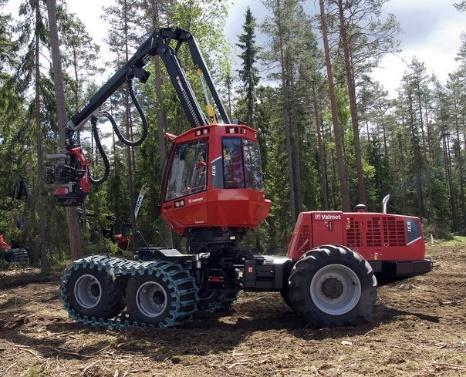
History
Forest harvesters were mainly developed in Sweden and Finland and today do practically all of the commercial felling in these countries. The first fully mobile timber "harvester", the PIKA model 75, was introduced in 1973 by Finnish systems engineer Sakari Pinomäki and his company PIKA Forest Machines. The first single grip harvester head was introduced in the early 1980s by Swedish company SP Maskiner. Their use has become widespread throughout the rest of Northern Europe, particularly in the harvesting of plantation forests.
Before modern harvesters were developed in Finland and Sweden, two inventors from Texas developed a crude tracked unit that sheared off trees at the base up to 30 inches in diameter was developed in the US called The Mammoth Tree Shears. After shearing off the tree, the operator could use his controls to cause the tree to fall either to the right or left. Unlike a harvester, it did not delimb the tree after felling it.
Uses
Harvesters are employed effectively in level to moderately steep terrain for clearcutting areas of forest. For very steep hills or for removing individual trees, humans working with chain saws are still preferred in some countries. In northern Europe small and manoeuvrable harvesters are used for thinning operations, manual felling is typically only used in extreme conditions, where tree size exceeds the capacity of the harvester head or by small woodlot owners.
The principle aimed for in mechanised logging is "no feet on the forest floor", and the harvester and forwarder allow this to be achieved. Keeping humans inside the driving cab of the machine provides a safer and more comfortable working environment for industrial scale logging.
Harvesters are built on a robust all terrain vehicle, either wheeled or tracked. The vehicle may be articulated to provide tight turning capability around obstacles. A diesel engine provides power for both the vehicle and the harvesting mechanism through hydraulic drive. An extensible, articulated boom, similar to that on an excavator, reaches out from the vehicle to carry the harvester head. Some harvesters are adaptations of excavators with a new harvester head, while others are purpose-built vehicles.
"Combi" machines are available which combine the felling capability of a harvester with the load-carrying capability of a forwarder, allowing a single operator and machine to fell, process and transport trees. These novel type of vehicles are only competitive in operations with short distances to the landing.
Felling head
A typical harvester head consists of (from bottom to top, with head in vertical position)
- a chain saw to cut the tree at its base, and also cut it to length. The saw is hydraulically powered, rather than using the 2-stroke engine of a portable version. It has a more robust chain, and a higher power output than any saw that can be carried by a human.
- two or more curved delimbing knives which reach around the trunk to remove branches.
- two feed rollers to grasp the tree. The wheels pivot apart to allow the tree to be embraced by the harvester head, and pivot together to hug the tree tightly. The wheels are driven in rotation to force the cut tree stem through the delimbing knives.
- diameter sensors to calculate the volume of timber harvested in conjunction with
- a measuring wheel which measures the length of the stem as it is fed through the head.
All of this can be controlled by one operator sitting in the cab of the vehicle. A control computer can simplify mechanical movements and can keep records of the length and diameter of trees cut. Length is computed by either counting the rotations of the gripping wheels or, more commonly, using the measuring wheel. Diameter is computed from the pivot angle of the gripping wheels or delimbing knives when hugging the tree. Length measurement also can be used for automated cutting of the tree into predefined lengths. Computer software can predict the volume of each stem based on analysing stems harvested previously. This information when used in conjunction with price lists for each specific log specification enables the optimisation of log recovery from the stem.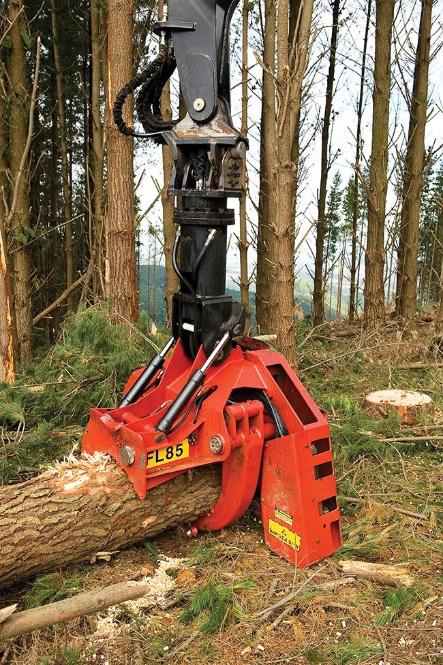
Harvesters are routinely available for cutting trees up to 900 mm in diameter, built on vehicles weighing up to 20 t, with a boom reaching up to 10 m radius. Larger, heavier vehicles do more damage to the forest floor, but a longer reach helps by allowing more trees to be harvested with fewer vehicle movements.
The approximate equivalent type of vehicle in full-tree logging systems are feller-bunchers.
Forwarder
A forwarder is a forestry vehicle that carries big felled logs from the stump to a roadside landing. Unlike a skidder, a forwarder carries logs clear of the ground, which can reduce soil impacts but tends to limit the size of the logs it can move. Forwarders are typically employed together with harvesters in cut-to-length logging operations.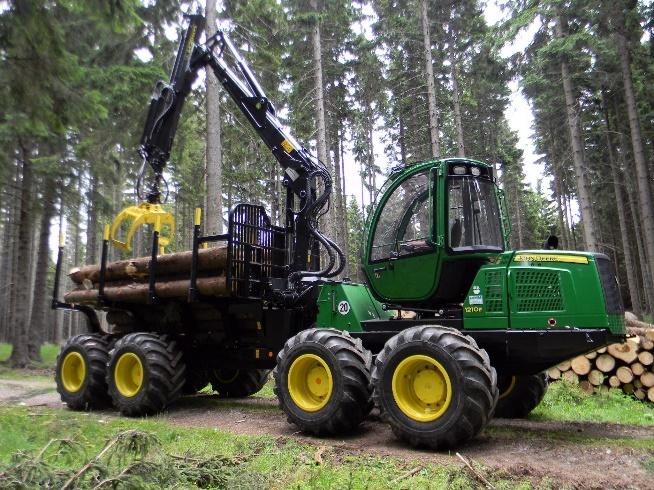
Forwarders are commonly categorised on their load carrying capabilities. The smallest are trailers designed for towing behind all-terrain vehicles which can carry around 250 kg to 500 kg. Agricultural self-loading trailers designed to be towed by farm tractors can handle load weights up to around 4 tonnes. Light weight purpose-built machines utilised in commercial logging and thinning operations can handle payloads of up to 8 tonnes. Medium sized forwarders used in clearfells carry between 12 and 14 tonnes with the largest class handling up to 20 tonnes.Forwarders also carry them at least 2 feet above the ground.
Skidder
A skidder is any type of heavy vehicle used in a logging operation for pulling cut trees out of a forest in a process called "skidding", in which the logs are transported from the cutting site to a landing. Here they are loaded onto trucks (or in times past, railroad cars or flumes), and sent to the mill. One exception is that in the early days of logging, when distances to the timberline from the mill were shorter, the landing stage was omitted altogether, and the "skidder" would have been used as the main road vehicle, in place of the trucks, railroad, or flume. Modern forms of skidders can pull trees with a cable/winch, just like the old steam donkeys, or a grapple or a clam-bunk.
History
Early skidders were pulled by a team of oxen, horses or mules. The driver would straddle the cart over felled logs, where dangling tongs would be positioned to raise the end of the log off the ground. The team pulled the tongue forward, allowing the log to "skid" along between the rolling wheels. These were known as "slip-tongue wheels" Starting in the early 1920s, animals were gradually replaced by gasoline-powered crawlers, although some small operations continue to use horses. In other places, steel "arches" were used behind the crawlers. Similar in function to the slip-tongue wheels, arches were used to reduce friction by raising up one end of the load, which was dangled from a cable which in turn ran down the back of the arch, & was raised or lowered by the crawler's winch. Another piece similar to the arch was the "bummer", which was simply a small trailer to be towed behind a crawler, on top of which one end of the log load would rest.
The early mechanical skidders were steam powered. They traveled on railroads, known as "dummylines" and the felled trees were dragged or "skidded" to the railroad where they were later loaded onto rail cars. Some were just steam donkeys, others were more complicated. One popular brand was the Clyde Skidder, built by Clyde Ironworks in Duluth, Minnesota. The Clyde skidder illustrated was photographed at the Marathon Lumber Company logging operations near Newton, Mississippi in the early 1920s. Although these machines appear to be large and cumbersome, they were true workhorses of their day. The Clyde was capable of retrieving logs from four different points at the same time. Each cable, or lead, was approximately 1000 feet in length. Once the logs were attached and a clearance signal was sent for retrieval, they could be skidded at a speed of 1000 feet per minute. Working conditions around these machines were very dangerous. The largest of these was the Lidgerwood skidder, which not only brought logs to the landing from the cutting site, but loaded them onto railroad cars as well, making it both a skidder & loader. In New Zealand cables were run five miles.
Modern equivalents
Contemporary skidders are tracked or four wheel drive tractors with a turbocharged diesel engine, winch and steel, funnel-shaped guards on the rear to protect the wheels. They have articulated steering and usually a small, adjustable, push-blade on the front. The operator/logger is protected from falling or flying debris (or parted cables, or rolling over) by a steel enclosure. They are one of the few logging machines that is capable of thinning or selective logging in larger timber. Forwarders can haul small short pieces out, but if mature timber is to be thinned, a skidder is one of the few options for taking out some trees while leaving others. While selective logging can be done badly in a host of ways, taking some trees while leaving some may be a preferred alternative to taking all the trees.
The skidder can also be used for pulling tree stumps, pushing over small trees, and preliminary grading of a logging path known as a "skid road".
A positive thing about the skidder is that while wood is being yarded (pulled), tree particles and seeds are cultivated into the soil.
One disadvantage of skidder logging in thinning operations is the damage to remaining trees as branches and trunks are dragged against them, tearing away the protective bark of living trees. Another concern is the deep furrows sometimes made by skidders in the topsoil, especially when using tires with chains, which alter surface runoff patterns and increases the costs of forest rehabilitation and reforestation.
Cable skidders
On a cable skidder, the cable is reeled out and attached to a pull of cut timber, then the winch pulls the load toward the skidder. The winch or grapple holds the trees while the skidder drags them to a landing area. Cable skidders are less popular than in the past. They are more labor-intensive than grapple skidders because someone (the operator or a second person) must drag the winch line out to the logs and hook them up. This is helpful where it is not possible to drive the machine close to the log (such as in steep hills).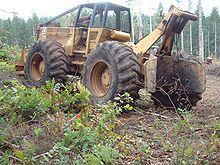
Grapple skidders
Modern dual function grapple skidder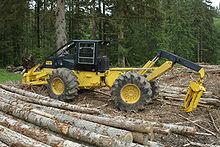
Alternatively, some skidders have a hydraulic grapple bucket instead of a winch, and the bucket—attached to the skidder by a boom—grabs and lifts the timber.
There are three types of 'fixed boom' grapple skidders. A single-function boom type has two hydraulic cylinders, only allowing the boom to lower in one position. Dual-function booms (as pictured) have four cylinders, which allows for adjusting the boom in two different places. The third type permits the grapple boom to be swung from side to side, allowing spread out trees to be grabbed at once.
In some areas, loggers have combined a hydraulic claw on the side with the blade of their grapple skidders, making it possible to pile logs in some cases. More common on cable skidders, this also permits hauling back bark and tops when returning from a landing area to a cut block.
Chippers
A tree chipper or woodchipper is a machine used for reducing wood (generally tree limbs or trunks) into smaller woodchips. They are often portable, being mounted on wheels on frames suitable for towing behind a truck or van. Power is generally provided by an internal combustion engine from 3 horsepower (2.2 kW) to 1,000 horsepower (750 kW). There are also high power chipper models mounted on trucks and powered by a separate engine. These models usually also have a hydraulic crane.
Tree chippers are typically made of a hopper with a collar, the chipper mechanism itself, and an optional collection bin for the chips. A tree limb is inserted into the hopper (the collar serving as a partial safety mechanism to keep human body parts away from the chipping blades) and started into the chipping mechanism. The chips exit through a chute and can be directed into a truck-mounted container or onto the ground. Typical output is chips on the order of 1 inch (2.5 cm) to 2 inches (5.1 cm) across in size. The resulting wood chips have various uses such as being spread as a ground cover or being fed into a digester during papermaking.
Most woodchippers rely on energy stored in a heavy flywheel to do their work (although some use drums). The chipping blades are mounted on the face of the flywheel, and the flywheel is accelerated by an electric motor or internal combustion engine.
Large woodchippers frequently are equipped with grooved rollers in the throat of their feed funnels. Once a branch has been gripped by the rollers, the rollers transport the branch to the chipping blades at a steady rate. These rollers are a safety feature and are generally reversible for situations where a branch gets caught on clothing.
Feller buncher
A feller buncher is a type of harvester used in logging. It is a motorized vehicle with an attachment that can rapidly cut and gather several trees before felling them.
Feller is a traditional name for someone who cuts down trees, and bunching is the skidding and assembly of two or more trees. A feller buncher performs both of these harvesting functions and consists of a standard heavy equipment base with a tree-grabbing device furnished with a chain-saw, circular saw or a shear - a pinching device designed to cut small trees off at the base. The machine then places the cut tree on a stack suitable for a skidder or forwarder, or other means of transport (yarding) for further processing (e.g., delimbing, bucking, loading, or chipping).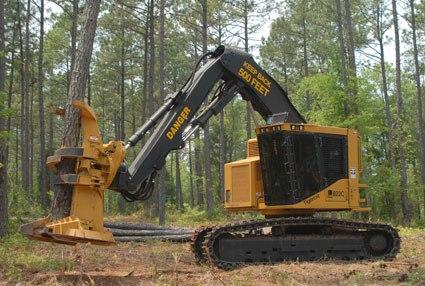
There are also wheeled feller bunchers with no articulated arm. Instead this type of vehicle drives close and grabs the tree.
In cut-to-length logging a harvester performs the tasks of a feller buncher and additionally does delimbing and bucking.
V. Traffic, rules and laws
Traffic
Traffic on roads may consist of pedestrians, ridden or herded animals, vehicles, streetcars, buses and other conveyances, either singly or together, while using the public way for purposes of travel. Traffic laws are the laws which govern traffic and regulate vehicles, while rules of the road are both the laws and the informal rules that may have developed over time to facilitate the orderly and timely flow of traffic.
Organized traffic generally has well-established priorities, lanes, right-of-way, and traffic control at intersections.
Traffic is formally organized in many jurisdictions, with marked lanes, junctions, intersections, interchanges, traffic signals, or signs. Traffic is often classified by type: heavy motor vehicle (e.g., car, truck); other vehicle (e.g., moped, bicycle); and pedestrian. Different classes may share speed limits and easement, or may be segregated. Some jurisdictions may have very detailed and complex rules of the road while others rely more on drivers' common sense and willingness to cooperate.
Organization typically produces a better combination of travel safety and efficiency. Events which disrupt the flow and may cause traffic to degenerate into a disorganized mess include: road construction, collisions and debris in the roadway. On particularly busy freeways, a minor disruption may persist in a phenomenon known as traffic waves. A complete breakdown of organization may result in traffic congestion and gridlock. Simulations of organized traffic frequently involve queuing theory, stochastic processes and equations of mathematical physics applied to traffic flow.
Traffic code
Traffic code (also motor vehicle code) refers to the collection of local statutes, regulations, ordinances and rules that have been officially adopted in the United States to govern the orderly operation and interaction of motor vehicles, bicycles, pedestrians and others upon the public (and sometimes private) ways.
The traffic code generally includes provisions relating to the establishment of authority and enforcement procedures, statement of the rules of the road, and other safety provisions. Administrative regulations for driver licensing, vehicle ownership and registration, insurance, vehicle safety inspections and parking violations may also be included, though not always directly related to driving safety. Violations of traffic code (i.e., a "moving violation") are often dealt with by forfeiting a fine in response to receiving a valid citation ("getting a ticket"). Other violations, such as drunk driving or vehicular homicide are handled through the criminal courts, although there may also be civil and administrative cases that arise from the same violation (including payment of damages and loss of driving privileges). In some jurisdictions there is a separate code-enforcement branch of government that handles illegal parking and other non-moving violations (e.g., noise and other emissions, illegal equipment). Elsewhere, there may be multiple overlapping police agencies patrolling for violations of state or federal driving regulations.
In the United States each state has its own traffic code, although most of the rules of the road are similar for the purpose of uniformity, given that all states grant reciprocal driving privileges (and penalties) to each other's licensed drivers. There is also a "Uniform Vehicle Code" which has been proposed by a private, non-profit group, based upon input by its members. As with many such offerings, some states adopt selected portions as written, or else with modifications, and others create their own versions. Similarly, most states have adopted relevant standards for signs and signals, based upon the Manual on Uniform Traffic Control Devices from the U.S. Department of Transportation. Many of the standard rules of the road involve consistent interpretation of the standard signs and signals, such as what to do when approaching a stop sign, or the driving requirements imposed by a double yellow line on the street or highway. Many federal departments have also adopted their own traffic code for enforcement on their respective reservations (e.g., national parks, military bases).
List of some standard Rules of the Road:
Entering and leaving roadways.
Right of way at marked and unmarked intersections under various conditions.
Observing and interpreting traffic signs (especially warning, priority or prohibitory traffic signs)
Keeping to right side (or left side) except to pass others, where passing is allowed.
Direction of travel and turning (one way, do not enter, no U-turn, etc.)
Speed, height, width and weight limits.
Bicycle and pedestrian priority.
Yielding to special vehicles (emergency, funeral, school bus).
Vehicle lighting and signalling.
Stopping if there has been a collision
Driving laws
A driver is subject to the laws of the jurisdiction in which he or she is driving. The rules of the road, driver licensing and vehicle registration schemes vary considerably between jurisdictions, as do laws imposing criminal responsibility for negligent driving, vehicle safety inspections and compulsory insurance. Most countries also have differing laws against driving while under the influence of alcohol or other drugs. Aggressive driving and road rage have become problems for drivers in some areas.
Some countries require a vision screening test for individuals to acquire or renew a driver's license. A 2010 systematic review found insufficient evidence to assess the effects of vision screening tests on subsequent motor vehicle crash reduction. The review concluded that there is a need to develop valid and reliable tools of vision screening that can predict driving performance.
Motorists are almost universally required to take lessons with an approved instructor and to pass a driving test before being granted a license. Almost all countries allow all adults with good vision and health to apply to take a driving test and, if successful, to drive on public roads. Saudi Arabia, however, bans women from driving vehicles (whether pedal or motor powered) on public roads. Saudi women have periodically staged driving protests against these restrictions.
Winter driving can pose serious hazards in countries with colder climates. In many countries, even after passing one's driving test, new motorists are initially subject to special restrictions. For example, in Australia, novice drivers are required to carry "P" ("provisional") plates, and are subject to alcohol limits, and other restrictions, for their first two years of driving. Many U.S. states now issue graduated drivers' licenses to novice minors. Typically, newly licensed minors may not drive or operate a motorized vehicle at night or with a passenger other than family members. The duration of the restriction varies from six months to until the driver is 18 years old. This is due to the mental aptitude of a young or unexperienced driver not being fully developed.
Rules of the road
Rules of the road and driving etiquette are the general practices and procedures that road users are required to follow. These rules usually apply to all road users, though they are of special importance to motorists and cyclists. These rules govern interactions between vehicles and with pedestrians. The basic traffic rules are defined by an international treaty under the authority of the United Nations, the 1968 Vienna Convention on Road Traffic. Not all countries are signatory to the convention and, even among signatories, local variations in practice may be found. There are also unwritten local rules of the road, which are generally understood by local drivers.
As a general rule, drivers are expected to avoid a collision with another vehicle and pedestrians, regardless of whether or not the applicable rules of the road allow them to be where they happen to be.
In addition to the rules applicable by default, traffic signs and traffic lights must be obeyed, and instructions may be given by a police officer, either routinely (on a busy crossing instead of traffic lights) or as road traffic control around a construction zone, accident, or other road disruption.
These rules should be distinguished from the mechanical procedures required to operate one's vehicle.
Traffic signs
Regulatory Signs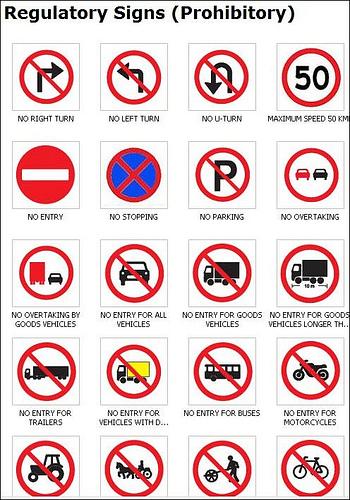
One type of regulatory signs are traffic signs intended to instruct road users on what they must or should do (or not do) under a given set of circumstances. Other types may be signs located on streets and in parking lots having to do with parking, signs in public parks and on beaches or on or in architectural facilities prohibiting specific types of activities. The term regulatory sign describes a range of signs that are used to indicate or reinforce traffic laws, regulations or requirements which apply either at all times or at specified times or places upon a street or highway, the disregard of which may constitute a violation, or signs in general that regulate public behavior in places open to the public.
Examples of non-traffic types of regulatory signs might be tow-away signs for vehicles without disabled parking stickers or no-smoking signs where there are laws prohibiting smoking.
Warning Signs
Warning signs are used to alert highway, street or road users to unexpected or dangerous conditions ahead that might call for a reduction of speed, situations that might not be readily apparent, or an action in the interest of safety and efficient traffic operations such as a curve, detour, sideroad, etc. They usually have a yellow or orange background with black symbols or letters on a diamond-shaped or rectangular sign. Yellow pennant-shaped signs caution motorists where passing is unsafe. Round yellow warning signs alert motorists that there's a railroad crossing ahead.
Warning signs are available in three material grades (engineer grade, high intensity, and x diamond grade) and in various sizes.
A traffic warning sign is a type of traffic sign that indicates a hazard ahead on the road that may not be readily apparent to a driver. If you don't see the signs you need we can make any standard or custom relfective sign.





Parking Signs
At Traffic sign Corp. our goal is to offer you the best prices, quality products & fast service on your parking signs, no parking signs, custom parking signs, handicapped signs, posts, hardware and so much more. All standard signs meet State and Federal MUTCD guidelines. Please give us the opportunity to help you with your church, school, shopping center or business parking signs. Put our many years of experience in the sign business to work for you. 
Construction Signs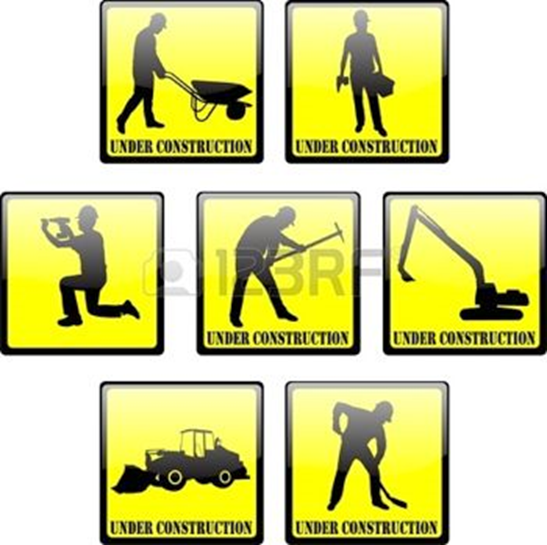
Construction signs are used to alert motorists to the dangers that new or temporary construction poses and how to maintain reasonable safety. These signs are identified by a bold orange color with black text or black symbols. This fluorescent orange material is built in a way to provided even higher visibility to help ensure the safety of the crews performing the construction.
Construction signs are available in three material grades (engineer grade, high intensity, and x diamond grade) and in various sizes.
Street signs
Street signs or road signs are signs erected at the side of or above roads to give instructions or provide information to road users. The earliest signs were simple wooden or stone milestones. Later, signs with directional arms were introduced, for example, the fingerposts in the United Kingdom and their wooden counterparts in Saxony.
With traffic volumes increasing since the 1930s, many countries have adopted pictorial signs or otherwise simplified and standardized their signs to overcome language barriers, and enhance traffic safety. Such pictorial signs use symbols (often silhouettes) in place of words and are usually based on international protocols. Such signs were first developed in Europe, and have been adopted by most countries to varying degrees.
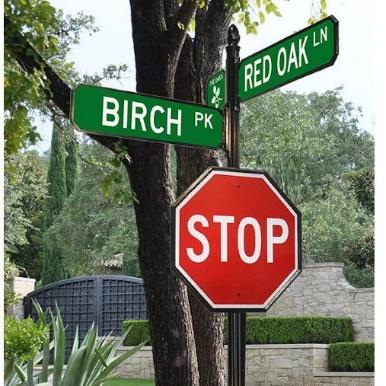
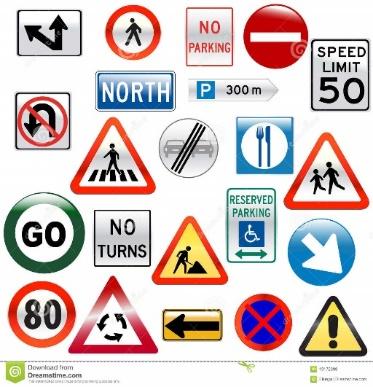
School Signs
A school zone refers to an area on a street near a school or near a crosswalk leading to a school that has a likely presence of younger pedestrians. School zones generally have a reduced speed limit during certain hours. School Area Signs will help you direct school traffic, parking and keep kids safe. Many signs now available in Fluorescent Yellow Green Sheeting.


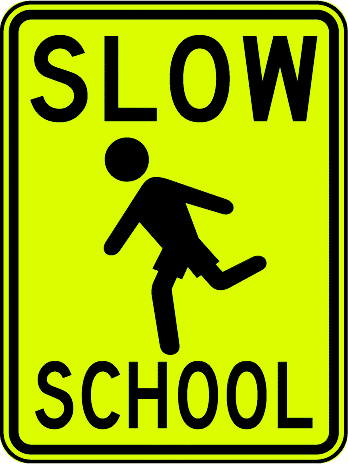
Guide Signs
Signs used to indicate locations, distances, directions, routes, and similar information.
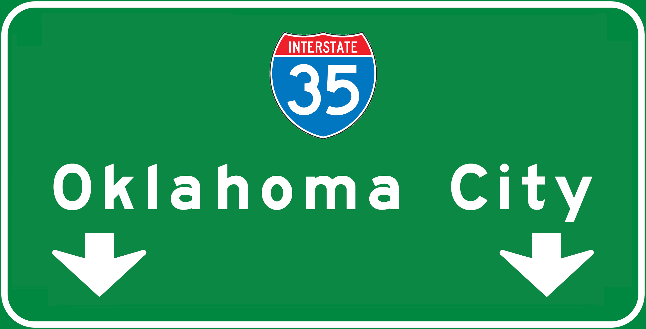
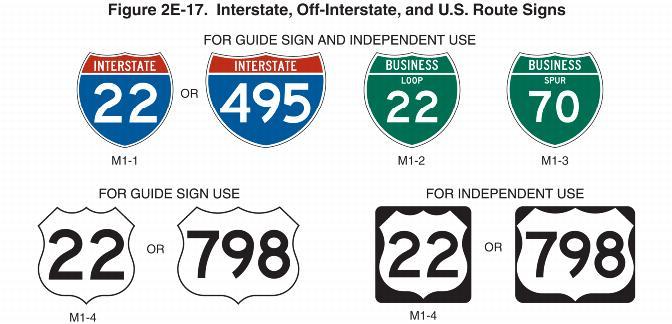
Список использованной литературы и интернет-источников:
Агабекян И.П. для средних специальных заведений, серия «Учебники и учебные пособия» - Ростов на Дону: «Феникс», 2010.
Андрианова Л.Н. «Курс Английского языка для студентов вечерних и заочных технических ВУЗов» - М.: «Высшая школа», 2007.
Агабекян И. П. Деловой английский, вузов по специальностям «Экономика и управление», серия «Учебники и учебные пособия» - Ростов на Дону: «Феникс», 2010.
Учебник английского языка для студентов технических университетов и вузов. Орловская И.В., Самсонова Л.С., Скубриева А.И. 6-е изд., стереотип. - М.: Изд-во МГТУ им. Н.Э. Баумана, 448,2006. .
Луговая А.Л. Английский язык для студентов энергетических специальностей; Учебное пособие. – 4-е изд., перераб. и доп. – М.: Высш.шк.., 2005. -150 с
Английский язык: задание No 126 для студентов I курса специальностей 190600 – эксплуатация транспортно-технологических машин и комплексов и 190700 – технология транспортных процессов / под ред. А.С. Глебовского; сост.: А.С. Глебовский, Н.Е. Дубовская; СПбГАСУ. – СПб., 2012. – 138 с.
http://www.vocabulary.cl/Advanced/Car_Parts.htm
http://www.english-online.at/travel/cars/cars-and-how-they-work.htm
http://www.tpub.com/machines/12d.htm
https://en.wikipedia.org/wiki/Harvester_%28forestry%29
https://en.wikipedia.org/wiki/Forwarder
https://en.wikipedia.org/wiki/Skidder
https://en.wikipedia.org/wiki/Woodchipper
https://en.wikipedia.org/wiki/Feller_buncher
https://en.wikipedia.org/wiki/Traffic
https://en.wikipedia.org/wiki/Traffic_code
https://en.wikipedia.org/wiki/Driving
https://en.wikipedia.org/wiki/Traffic#Rules_of_the_road
https://en.wikipedia.org/wiki/Traffic_sign
© 2016, Воронина Марина Владимировна 28570 267
Рекомендуем курсы ПК и ППК для учителей
Похожие файлы
Полезное для учителя























